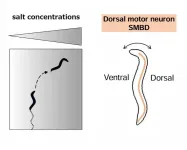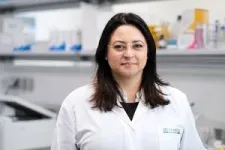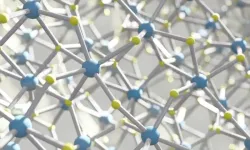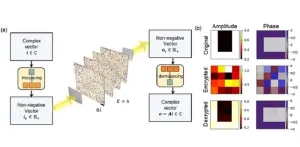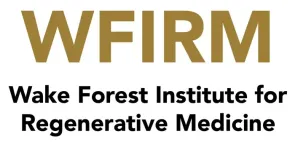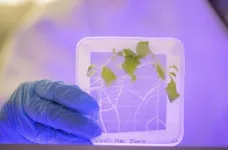Follow the salt: connecting salt concentrations and motion in roundworms
Scientists reveal the neural mechanisms triggered by temporal changes in environmental salt concentrations
2024-01-22
(Press-News.org)
Joint research led by Ayaka Matsumoto and Yuichi Iino of the University of Tokyo demonstrated that temporal decrease in salt concentration leads to the activation of the neck motor neuron of roundworms only in a specific phase of its activity. The activation adjusts the roundworm's trajectory toward higher salt concentrations. The finding pinpoints the neural mechanism by which roundworms integrate sensory and motor information, a first step toward understanding the neural mechanisms of navigation in more complex animals. The findings were published in the journal Proceedings of the National Academy of Sciences (PNAS).
It took human civilization thousands of years of concentrated effort to build (somewhat) self-driving vehicles. Yet even the simplest animals can integrate sensory information about their environments and adjust their movements accordingly. As such, the integration of sensory information and motor control is one of the most fundamental questions a biologist can tackle. This is precisely what the research team decided to undertake using a species of roundworm called Caenorhabditis elegans. C. elegans’ total of 302 neurons is completely mapped, making it manageable to manipulate and observe the effects of a single neuron.
“Roundworms travel by curving slowly toward regions with higher salt concentrations,” explains Matsumoto, the first author of the paper. “To control this curving behavior, roundworms need to detect the salt concentrations perpendicular to the path of their movements. However, they only have a single point ‘sensor,’ which makes it impossible for them to detect salt concentrations in space. Therefore, roundworms must be processing temporal changes in salt concentrations to recognize the preferred side.”
To investigate this hypothesis, the team used a “head-swing chip,” a tiny device that allows the worms to move their heads freely. Then, the researchers observed how the animals “clamped” in this device reacted to increasing or decreasing salt concentrations.
Roundworms move around by contracting the muscles that run along the longer axis of their bodies. As a result, their heads swing back and forth between the direction of their stomachs (ventral side) and backs (dorsal side), eventually curving more toward the direction they intend to go. Here, the researchers found that decreasing salt concentrations activated the dorsal neck neuron SMBD only in a specific phase of its activity, and its activity strongly correlated with neck swings. The activation of SMBD in response to decrease in salt concentration corresponded to the timing when the neck was bending toward the ventral side. This suggested that SMBD detects the lower salt concentrations on the ventral side of the body. Furthermore, the team revealed that artificial activation of SMBD during neck bending toward the ventral side made subsequent ventral neck bending shallower. Combining their results, the team inferred that SMBD plays a role not only in detecting changes in salt concentrations but also in suppressing neck bending toward the side with lower concentrations. It thus directs the worm toward higher salt concentrations.
“Even though we found that SMBD neuron integrates sensory and motor information, the molecular mechanisms of integration remain unknown,” Matsumoto says, pointing to future research. “Therefore, we are interested in what is going on inside the SMBD neuron while it senses salt concentration changes and neck movements. Also, we would love to look at the activity of all the neurons in the brain at the same time during navigation.”
END
ELSE PRESS RELEASES FROM THIS DATE:
2024-01-22
“Stability and wealth of nations and our civilisation depends on the stability of critical Earth system functions that operate beyond national borders. At the same time, human activities push harder and harder on the planetary boundaries of these pivotal systems. From the Amazon rainforest to the Greenland ice masses, there are rising risks of triggering irreversible and unmanageable shifts in Earth system functioning. As these shifts affect people across the globe, we argue that tipping elements should be ...
2024-01-22
EMBARGOED: NOT FOR RELEASE UNTIL 3:00 P.M. U.S. EASTERN TIME ON JANUARY 22, 2024
Scientists and engineers have been pushing for the past decade to leverage an elusive ferroelectric material called hafnium oxide, or hafnia, to usher in the next generation of computing memory. A team of researchers including the University of Rochester’s Sobhit Singh published a Proceedings of the National Academy of Sciences study outlining progress toward making bulk ferroelectric and antiferroelectric hafnia available for use in a variety of applications.
In a specific crystal phase, hafnia exhibits ferroelectric properties—that is, electric polarization that can be changed in one direction ...
2024-01-22
State-of-the-art neural networks heavily rely on linear operations, such as matrix-vector multiplications and convolutions. While dedicated processors like GPUs and TPUs exist for these operations, they have limitations in terms of power consumption and bandwidth. Optics is better suited for such operations because of its inherent parallelism, large bandwidth, and computation speed.
Diffractive deep neural networks (D2NN), also known as diffractive networks, constitute an emerging optical computing architecture. ...
2024-01-22
Winston Salem, NC – January 22, 2024 - The Wake Forest Institute for Regenerative Medicine, part of Wake Forest University School of Medicine, has been selected to lead the Armed Forces Institute of Regenerative Medicine (AFIRM) Consortium. The project - a $40 million, five year-long award from the Defense Health Agency (DHA) - will focus on taking regenerative medicine solutions for battlefield injuries to the next level, and ultimately to the general public.
Regenerative medicine is a science that takes advantage of the body's natural abilities to restore or replace damaged tissue and organs. WFIRM has managed two prior AFIRM consortia since ...
2024-01-22
A decade that began with a global shutdown is a third of the way done. Its finale — a major deadline for reducing U.S. carbon emissions to slow climate change — approaches at the usual clip. With the decade’s halfway mark in view, the U.S. Department of Energy (DOE) Gateway for Accelerated Innovation in Nuclear (GAIN) awarded seven new vouchers to companies and national laboratories working to develop and commercialize clean nuclear energy projects. Nuclear energy is considered central to efforts to minimize carbon emissions and still reliably meet rising ...
2024-01-22
Rutgers researchers can predict which patients will benefit from a popular prostate cancer drug – and have devised a strategy that may make the treatment work longer.
“This work should help doctors know which patients’ prostate cancers will and won’t respond to the androgen deprivation therapy enzalutamide, which can slow prostate cancer growth by disrupting androgen receptor signaling,” said Antonina Mitrofanova, associate professor of Biomedical and Health Informatics, associate dean for research at the Rutgers School of Health Professions, researcher at Rutgers Cancer ...
2024-01-22
Lettuce and other leafy green vegetables are part of a healthy, balanced diet — even for astronauts on a mission.
It’s been more than three years since the National Aeronautics and Space Administration made space-grown lettuce an item on the menu for astronauts aboard the International Space Station. Alongside their space diet staples of flour tortillas and powdered coffee, astronauts can munch on a salad, grown from control chambers aboard the ISS that account for the ideal temperature, amount of water and light ...
2024-01-22
Toronto, ON – While there has been much public scrutiny and research on police interactions and violence towards sexual minorities in the United States, there is a gap in the current literature on how sexual minorities fare with law enforcement contact in Canada. A new study published in the Annals of Epidemiology aims to fill this research gap by examining the relationship between sexual orientation and experiences with police contact, including intrusion and harassment from the police, in Canada.
Among a sample of 940 adolescents and young adults across Canada, the study found that the prevalence of police contact was highest among persons ...
2024-01-22
CLEVELAND -- Joseph Welles Henderson, MD, of University Hospitals has been named an InterStim™ Center of Excellence by Medtronic (NYSE: MDT), the world’s largest medical device manufacturer. The designation is awarded to caregivers who have demonstrated particular expertise in the use of the InterStim™ system to treat overactive bladder, as well as non-obstructive urinary retention and chronic fecal incontinence.
Dr. Henderson is an OBGYN and urologist, and specializes in female pelvic medicine and reconstruction ...
2024-01-22
SAN ANTONIO, Jan. 22, 2024 — A ribbon of brain tissue called cortical gray matter grows thinner in people who go on to develop dementia, and this appears to be an accurate biomarker of the disease five to 10 years before symptoms appear, researchers from The University of Texas Health Science Center at San Antonio (also called UT Health San Antonio) reported.
The researchers, working with colleagues from The University of California, Davis, and Boston University, conducted an MRI brain imaging study published ...
LAST 30 PRESS RELEASES:
[Press-News.org] Follow the salt: connecting salt concentrations and motion in roundworms
Scientists reveal the neural mechanisms triggered by temporal changes in environmental salt concentrations
